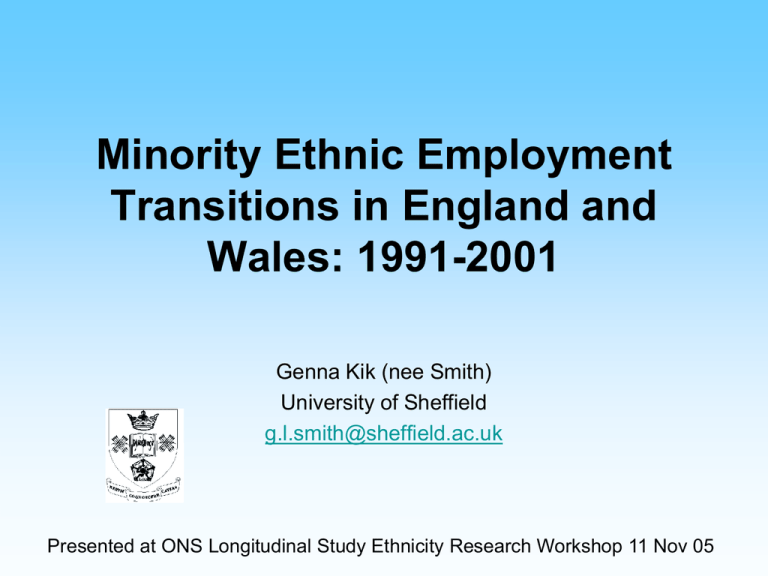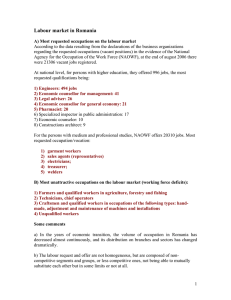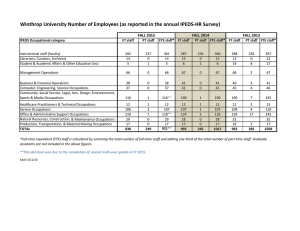Minority Ethnic Employment Transitions in England and Wales: 1991-2001 Genna Kik (nee Smith)
advertisement

Minority Ethnic Employment Transitions in England and Wales: 1991-2001 Genna Kik (nee Smith) University of Sheffield g.l.smith@sheffield.ac.uk Presented at ONS Longitudinal Study Ethnicity Research Workshop 11 Nov 05 Aims and Scope of Paper Paper examines the degree to which different ethnic groups are concentrated in certain occupations in England and Wales. In particular the paper considers whether ethnic clusters in the labour market have changed over the past ten years between 1991-2001 by studying ethnic transitions in the labour market. 2 Outline National Level Using the ONS Longitudinal Study - the positives and negatives Research Framework In depth: Ethnic Employment Transitions Future Research – Geographical Variation Geography and the ONS Longitudinal Study – Problems and Positives Sub-national Ethnic Employment Transitions 3 Positives and the negatives of using the ONS Longitudinal Study for this research + • Large sample for studying ethnic groups compared to other data sources • Following the trajectories of the same individuals over time • No alterations, top coding, or grouping of small categories • SOC 90 coded for 2001 census data • Imputed values flagged • Cell counts get small very quickly when doing cross-tabs – particularly if using ethnicity • Continual process of negotiation whether to suppress or aggregate cells • Problems with both strategies – possible to see tables before deciding on which strategy to use. 4 • • • • • Research Framework – National Level 8 Ethnic Groups SOC 90 Major Categories SOC 90 Sub-Major Categories (Cross-sections only) Economic Activity – 4 groups Individuals present at 1991 and 2001 (Major Level) – Data also received for males and females, and three different age cohorts by Ethnic group • Output from ONS Longitudinal Study: Cross-tabs • Main Research Methods: Transition matrixes, location quotients, shift-share analysis. 5 Standard Occupational Classification (SOC 90) • Managers and Administrators (Corporate Managers and Administrators; Managers/Proprietors in Agriculture and Services) • Professionals (Science and Engineering Professionals; Health Professionals; Teaching Professionals; Other Professionals) • Associate Professional and Technical Occupations (Science and Engineering Associate Professionals; Health Associate Professionals; Other Associate Professionals) • Clerical and Secretarial (Clerical Occupations; Secretarial Occupations) • Craft and Related Occupations (Skilled Construction Trades; Skilled Engineering Trades; Other Skilled Trades) • Personal and Protective Service Occupations (Protective Services; Personal Services) • Sales Occupations (Buyers, Brokers and Sales Reps; Other Sales Occupations) • Plant and Machine Operatives (Industrial Plant and Machine Operators, Assemblers; Drivers and Mobile Machine Operators) • Other Occupations (Other Occupations in Agriculture, Forestry and Fishing; Other Elementary Occupations) 6 Measuring Occupational Concentration: Location Quotients 1991 LQ Major Occupation 1991, All Persons Other Other Chinese Bangladeshi Pakistani Indian Black African Black Caribbean White Underrepresented Managers and Administrators 1.018 0.356 0.543 0.99 0.539 0.366 1.374 0.603 Professional Occupations 1.015 0.465 0.987 0.919 0.426 0.278 0.835 1.086 Associate Professional and Technical Occupations 1.009 1.504 1.495 0.64 0.293 0 1.536 1.281 Clerical and Secretarial Occupations 1.019 1.132 0.823 0.754 0.35 0.08 0.514 0.856 Craft and Related Occupations 1.022 0.86 0.3 0.916 0.497 0.321 0.067 0.445 Personal and Protective Service Occupations 1.013 1.536 0.854 0.343 0.298 1.512 2.439 0.926 Sales Occupations 1.024 0.461 0.411 0.898 0.428 0.118 0.547 0.617 0.99 1.274 0.451 1.729 1.362 0.243 0.112 0.448 Other Occupations 1.022 1.262 0.975 0.647 0.379 0.232 0.34 0.599 Unemployed* 0.954 1.929 2.467 1.394 2.081 2.343 1.265 1.538 Student~ 0.958 1.049 3.442 1.44 1.354 1.922 2.631 2.064 0.98 0.769 0.922 1.088 2.203 2.606 1.3 0.986 Other Inactive# 1.014 1.155 0.733 0.808 0.804 0.702 0.467 0.503 Aged 6-15 0.978 0.901 1.042 1.172 1.597 1.82 1.191 1.741 Plant and Machine Operatives Looking after home/family Source: ONS Longitudinal Study Overrepresented Highly Overrepresented 7 Measuring Occupational Concentration 2: Location Quotients 2001 LQ Major Occupation 2001, All Persons Other Chinese Bangladeshi Pakistani Indian Black African Black Caribbean White Underrepresented Managers and Administrators 1.014 0.596 0.713 0.981 0.537 0.406 1.126 0.808 Professional Occupations 0.994 0.662 1.593 1.236 0.731 0.346 1.675 1.52 Associate Professional and Technical Occupations 1.012 1.172 1.625 0.648 0.249 0.152 1.408 1.245 Clerical and Secretarial Occupations 1.011 1.175 1 0.882 0.492 0.303 0.632 0.955 1.03 0.727 0.125 0.735 0.364 0.139 0 0.432 Personal and Protective Service Occupations 1.009 1.118 1.458 0.521 0.507 1.315 2.077 1.079 Sales Occupations 1.008 0.541 0.24 1.104 0.723 0.631 0.919 1.023 Plant and Machine Operatives 0.998 0.864 0.609 1.433 1.425 0.315 0.09 0.61 Other Occupations 1.018 0.862 0.907 0.865 0.419 0.192 0.605 0.738 Unemployed* 0.951 1.98 2.359 1.344 2.269 2.327 1.208 1.86 Student~ 0.935 1.297 2.329 1.958 2.195 2.269 1.994 2.507 Looking after home/family 0.964 0.885 0.887 0.998 3.032 4.009 1.321 1.222 Other Inactive# 1.004 1.187 0.721 0.919 1.058 1.196 0.746 0.642 Craft and Related Occupations Source: ONS Longitudinal Study Overrepresented Highly Overrepresented 8 Change in Labour Market Concentration by Ethnic Group: 1991-2001 (Occupation and Econom ic Activity) White 2 B lack Caribbean B lack A frican 1.5 Indian Change in LQ 1 P akistani B angladeshi 0.5 Chinese Other Other 0 -0.5 -1 -1.5 M an ager s an d Pr of ession al Associat e Cler icalan d Cr af t an d Per son alan d Plan t an d Ot her Admin ist r at or s Occupat ion s Pr of ession alan d Secr et ar ial Relat ed Pr ot ect ive M achin e Occupat ion s T echn ical Occupat ion s Occupat ion s Ser vice Oper at ives Sales Occupat ion s Un employed* St uden t ~ Lookin g af t er Ot her I n act ive# home/ f amily Occupat ion s Occupat ion s Occupation (SOC 90) and Econom ic Activity Source: ONS Longitudinal Study 9 The Indian Group: Progress and Stability Stability • Modest employment growth compared to other ethnic groups in sample • 41% retained same occupational group between 1991-2001 • No large changes in occupational concentration • Concentration in Managerial and Administrative; Associate Professional; and Clerical and Secretarial occupations remained same Progress • Professional Occupations – – – – Growth High levels of retention Increased concentration New entrants and upwards labour market mobility – Sub-major level stability: remained highly overrepresented as health professionals, underrepresented as teaching professionals – Sub-major level growth: Science and Engineering professionals doubled in numbers, shift from proportional to overrepresentation • Personal and Protective Services and Sales 10 Continued…The Indian Group: Progress and Stability Some Occupational Decline Future • Craft and Related Occupations • Plant and Machine Operatives • Evidence from TM helped fuel job growth in other occupational groups • Though higher proportions than other occupational groupings ending up in unemployment and other inactive • Steady improvement looks set to continue – Increased numbers remaining in post-16 education, and increases in concentration – Evidence from 1991-2001, good track record of translating post-16 education into employment – 1991-2001 good proportion of individuals moving from unemployment into jobs compared to other ethnic groups – Job losses translated into alternative employment 11 Black Caribbean Group: Labour Market Polarity • Only group to experience job decline • One of weakest labour market positions • Labour market polarity – gains made at ‘higher end’ of labour market, and losses at the lower levels • Job losses in lower levels did not translate into upward progression in labour market • New entrants to the labour market fuelling job growth • Widening of intra-group disparities? 12 Continued…Black Caribbean Labour Market Polarity Increasing Occupational Concentration • Managers and Administrators • Professional Occupations • Sources of Growth – Upwards Occupational Mobility (Clerical and Secretarial, Associate Professional) – New entrants (Students) Job Decline • Large losses: Craft and Related Occupations, Plant and Machine Operatives, Other Occupations • Other Losses: Personal and Protective Services • Large numbers entering Other Inactive rather than a different occupational group 13 Black Caribbean Destinations 2001: Occupation (SOC 90 Major) Managers and Administrators Professional Occupations Associate Professional and Technical Occupations Clerical and Secretarial Occupations Craft and Related Occupations Personal and Protective Service Occupations Sales Occupations Plant and Machine Operatives Other Occupations % Retaining % Entering a % Entering Occupational Different Unemployment Group 1991- Occupational in 2001 2001 Group in 2001 37% 51.8% Nil % Entering Other Inactive in 2001 10.6% 54% 33.3% Nil 12.2% 47.5% 27.5% 2% 21% 45.6% 33.7% 3.6% 8.1% 28.6% 20% 8.4% 26.7% 30.56% 24% 3.3% 37.6% 30.5% 26.2% 36.1% 27% Nil 4.5% 33.3% 40.1% 19% 22% 5.7% Source: ONS Longitudinal Study (Derived from BC Transition Matrix) 50.6% 14 Black Caribbean Occupation 2001 Manage rs and Adminis trators Professi onal Occupat ions Black Caribbean Occupation 1991 Associat e Professi onal and Technic al Occupat ions Clerical and Secretar ial Occupat ions Craft and Related Occupat ions Personal and Protecti ve Service Occupat ions Sales Occupat ions Plant and Machin e Operati ves Other Occupat ions Unempl oyed* Student ~ Other Inactive # Looking after home/fa mily Total Managers and Administrators 37.65% 5.88% 10.59% 17.65% 5.88% 7.06% 4.71% 0.00% 0.00% 0.00% 0.00% 10.59% 0.00% 17.39% 4.55% 4.66% 4.95% 3.88% 3.35% 7.84% 0.00% 0.00% 0.00% 0.00% 1.18% 0.00% Professional Occupations 22.81% 54.39% 10.53% 0.00% 0.00% 0.00% 0.00% 0.00% 0.00% 0.00% 0.00% 12.28% 0.00% 7.07% 28.18% 3.11% 0.00% 0.00% 0.00% 0.00% 0.00% 0.00% 0.00% 0.00% 0.92% 0.00% 9.50% 8.50% 47.50% 3.50% 0.00% 3.50% 0.00% 2.50% 0.00% 2.00% 0.00% 21.00% 2.00% Associate Professional and Technical Occupations 10.33% 15.45% 49.22% 2.31% 0.00% 3.91% 0.00% 4.24% 0.00% 2.68% 0.00% 5.51% 2.70% Clerical and Secretarial Occupations 11.97% 3.88% 7.77% 45.63% 1.29% 3.56% 2.59% 1.29% 1.29% 3.56% 2.27% 8.09% 6.80% 20.11% 10.91% 12.44% 46.53% 3.10% 6.15% 15.69% 3.39% 4.21% 7.38% 3.48% 3.28% 14.19% Craft and Related Occupations 4.19% 2.09% 2.62% 0.00% 44.50% 0.00% 0.00% 8.38% 3.14% 8.38% 0.00% 26.70% 0.00% 4.35% 3.64% 2.59% 0.00% 65.89% 0.00% 0.00% 13.56% 6.32% 10.74% 0.00% 6.69% 0.00% Personal and Protective Service Occupations 6.10% 3.76% 5.63% 3.29% 0.00% 28.64% 0.00% 1.88% 3.76% 3.29% 1.88% 37.56% 4.23% 7.07% 7.27% 6.22% 2.31% 0.00% 34.08% 0.00% 3.39% 8.42% 4.70% 1.99% 10.50% 6.08% Sales Occupations 22.22% 0.00% 0.00% 13.89% 0.00% 0.00% 30.56% 0.00% 0.00% 0.00% 0.00% 33.33% 0.00% 4.35% 0.00% 0.00% 1.65% 0.00% 0.00% 21.57% 0.00% 0.00% 0.00% 0.00% 1.57% 0.00% Plant and Machine Operatives 4.46% 0.00% 0.00% 6.93% 5.45% 4.46% 0.00% 26.24% 5.94% 4.46% 0.00% 40.10% 1.98% 4.89% 0.00% 0.00% 4.62% 8.53% 5.03% 0.00% 44.92% 12.63% 6.04% 0.00% 10.63% 2.70% Other Occupations 0.00% 0.00% 0.00% 6.33% 0.00% 8.23% 0.00% 6.96% 18.99% 5.70% 0.00% 50.63% 3.16% 0.00% 0.00% 0.00% 3.30% 0.00% 7.26% 0.00% 9.32% 31.58% 6.04% 0.00% 10.50% 3.38% 4.32% 2.33% 4.32% 10.96% 5.65% 5.98% 2.33% 5.32% 5.32% 10.30% 1.33% 34.55% 7.31% 7.07% 6.36% 6.74% 10.89% 13.18% 10.06% 13.73% 13.56% 16.84% 20.81% 1.99% 13.65% 14.86% 15.38% 16.35% 7.69% 15.38% 0.00% 7.69% 0.00% 4.81% 0.00% 8.65% 7.69% 10.58% 5.77% Student~ 8.70% 15.45% 4.15% 5.28% 0.00% 4.47% 0.00% 4.24% 0.00% 6.04% 3.98% 1.44% 4.05% Other Inactive# 0.00% 0.00% 0.00% 0.00% 0.00% 0.00% 0.00% 0.00% 0.00% 0.00% 0.00% 97.24% 2.76% 0.00% 0.00% 0.00% 0.00% 0.00% 0.00% 0.00% 0.00% 0.00% 0.00% 0.00% 23.10% 3.38% 3.24% 1.85% 4.63% 7.87% 0.00% 13.89% 0.00% 0.00% 4.17% 5.56% 2.78% 30.56% 25.46% 3.80% 3.64% 5.18% 5.61% 0.00% 16.76% 0.00% 0.00% 9.47% 8.05% 2.99% 8.66% 37.16% 2.44% 1.36% 2.98% 10.30% 1.90% 4.34% 5.69% 1.08% 2.71% 11.11% 46.61% 4.88% 4.61% 4.89% 4.55% 5.70% 12.54% 5.43% 8.94% 41.18% 3.39% 10.53% 27.52% 85.57% 2.36% 11.49% 100.00% 100.00% 100.00% 100.00% 100.00% 100.00% 100.00% 100.00% 100.00% 100.00% 100.00% 100.00% 100.00% Unemployed* Looking after home/family Aged 6-15 Total Source: ONS Longitudinal Study 100.00% 100.00% 100.00% 100.00% 100.00% 100.00% 100.00% 100.00% 100.00% 100.00% 100.00% 100.00% 100.00% 100.00% 15 The Black African Group: Change, Diversity and Progress Change and Diversity • One of fastest growing ethnic groups in UK • In LS sample size for cross-sectional cross tabs more than doubled for group • Internally diverse – increasingly so with new arrivals. • • • • LS Sample Small sample compared to some minority ethnic groups May miss wider changes that have occurred Cross-sectional results may be different Advantage of the LS: stable and settled Black African group can be traced 16 Continued…The Black African Group: LM Progress • High rates of job growth: Managerial and Administrative, Professional, Associate Professional and Personal and Protective Service Occupations • Key increases in labour market concentration: Professional Occupations, Personal and Protective Service Occupations 17 The Pakistani Group • Good Employment Growth • However more individuals remain out of the labour market than in • High numbers outside the labour market has a downward effect on occupational concentrations, so… • The group remained underrepresented in all occupations except Plant and Machine Operatives, where the group were overrepresented in both years. • Differences between Males and Females in 1991 and 2001 18 Continued…The Pakistani Group • If look at only those in employment a different picture emerges • By 2001 compared to the working population the group is proportionally or overrepresented in all but two occupational groups – Associate Professionals and Craft and Related. • Professional Occupations and Sales stand out as having strong increases in occupational concentration compared to the working population • Continue to be highly overrepresented in Plant and Machine Operatives compared to the working population • Future: Largest increase of concentration in post-16 education - should fuel further job growth. However 37% of those who were students in 1991 were not in employment by 2001, compared with only 14% of the Indian group, for example, in a similar situation. 19 Future Research: Geographical Variation • Much of the literature on the labour market position of minority ethnic group’s ignores the possibility labour market profiles may vary across space. • However there may be locally specific structures of constraint and opportunity at work resulting in varying labour market profiles across space for different groups. • Examining local specificity may hold the key for identifying the conditions that create, exacerbate, and transform the labour market position of different groups. 20 Geography and the ONS Longitudinal Study: Positives and Pitfalls + • Range of geographical units to choose from • Not limited to Standard Regions • Can capture population living in same area at two census points or more • Can look at differences between those who have stayed in an area and those who have left/or arrived more recently • Geographical consistency? • Smaller geographical units are difficult if also looking at ethnicity • Metropolitan Areas were the lowest level geography available for this research • At Metropolitan level, in some areas some ethnic groups do not have sufficient cell sizes 21 Research Framework: SubNational Level • 8 Ethnic Groups • 6 Metropolitan Areas: Inner London, Outer London, Greater Manchester, West Yorkshire, South Yorkshire, and West Midlands • SOC 90 Major Categories • Economic Activity – 4 groups • Movers and Non-Movers • Output from ONS Longitudinal Study: Cross-tabs • Main Research Methods: Location quotients, shift-share analysis. 22






